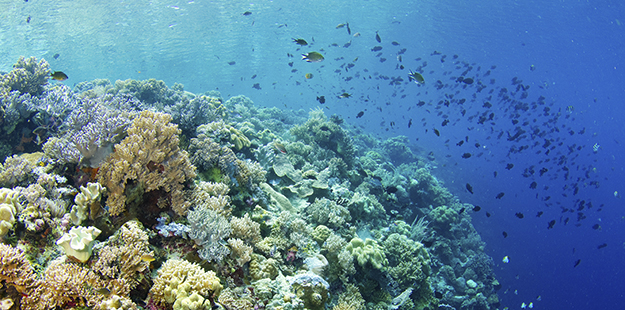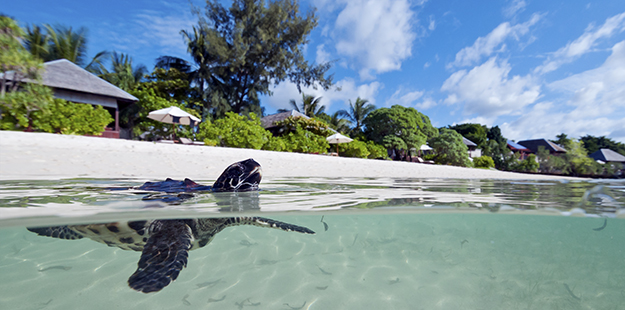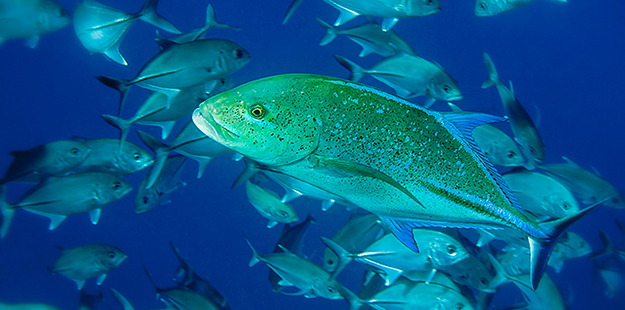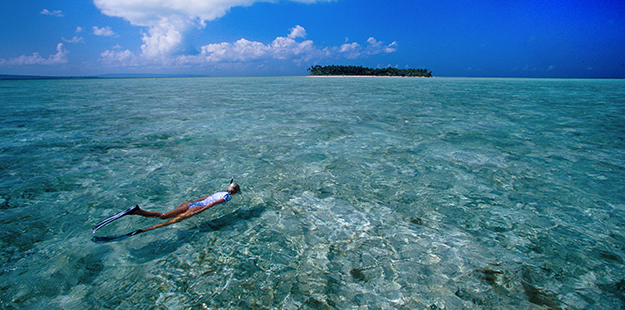Shooting in the Shallows
At Wakatobi Resort, photographers find opportunities close to the surface
Wakatobi Resort is a favorite with photographers, and serious underwater shooters from around the world come to document the diverse array of marine life found on our dive sites. Most don scuba gear and can spend hours each day searching for the perfect subject. But one need not go deep to create memorable images. The shallow reef tops found at many sites provide ample opportunities to create equally stunning images without the need for scuba. So leave the tanks behind and don mask and snorkel to discover the freedoms and creativity of a shallow water photo shoot.

Wakatobi’s shallow reef tops and drop offs provide endless opportunities for creating stunning images while snorkeling. Photo by Walt Stearns

Snorkel shooters often find the opportunity to capture portraits of tiny mariners as they head out to sea, including creative split images like this one taken in front of the resort. Photo by Glen Cowans
An exercise in simplicity
One of the true joys of snorkel photography is the potential simplicity. With ample ambient light falling on the shallows, there is usually no need for off-camera strobes and all their attendant hardware. In fact, a simple point-and-shoot camera is often all that is needed to create some interesting images. On the other hand, photographers who bring a housed mirrorless or DSLR systems open up a whole new range of possibilities. Whatever camera is selected for a snorkeling shoot, it should be as streamlined as possible, and neutrally buoyant or only slightly negative in the water. A buoyant rig, while it might seem easier to manage while swimming, can be more difficult to aim, and will require extra effort to control when diving below the surface. Any concerns about dropping the camera can be eliminated through the addition of a simple wrist lanyard. By working with the consistent light levels found at or near the surface, snorkelers are able to lock in the exposure level and focus on other variables such as composition and focus.

If your goal is to capture portraits of fellow snorkelers using a wide-angle lens, shooting in the morning or early afternoon can offer the best ambient light, provided you maintain awareness of the sun’s position–behind you or to your side. Photo by Walt Stearns

To create crisp images, even of constantly moving fish such as these cobalt jacks captured on the House Reef, try maintaining a minimum shutter speed of at least 125th of a second, or better yet, 160th to 200th. Photo by Pam Osborn
Wide works well
If the goal is to capture reef scenics, portraits of fellow snorkelers, and images of mid-sized fish, a wide-angle lens is best. For this type of ambient light shooting, morning or early afternoon light is often best, provided you maintain awareness of the sun’s position, and keep it behind you or to one side. The exception to this rule would be cases where an intentional backlighting effect is desired. Even the most accomplished snorkeler can’t hold perfectly still while shooting, and subjects such as fish are often also in motion. To freeze these small movements and create crisp images, you’ll want to maintain a minimum shutter speed of at least 125th of a second, and 160th to 200th is better. If lower light levels can’t be offset with greater aperture settings, you’ll want to increase the ISO rather than drop the shutter speed.
Overheads are OK
The old adage of getting level with the subject doesn’t necessarily apply to snorkeling photography. In fact, shooting from the surface can create some very dramatic images. If nothing else, surface shots capture the details of the reef from the same perspective that snorkelers view the environment. Shooting from the surface also allows you ample time to compose and anticipate the shot without the time pressure constraints of a breath hold. And by looking down, you often see patterns and compositions that aren’t apparent when viewed from a horizontal perspective, or from below. Overhead shots work well for many bottom-dwelling subjects, which can be found hiding in cover, creeping along the bottom or peering from a burrow. For best results, you’ll want to stick with stationary or slower-moving subjects.

Surface shots can capture the brilliant details of the reef from the same perspective that snorkelers view the environment. Photo by Jim Watt
In a macro mood
Photographers looking to take their snorkeling shoots to the next level can switch to macro mode, which adds a whole new realm of possibilities to your snorkeling excursions. In many cases, you will need to include strobes for close-in work, and two is better than one. This obviously increases the size of the camera rig, and therefore the drag. The good news is that you can usually get away with smaller strobes and shorter arms that would be the case in deeper waters. An all-around macro lens in the 50 to 60mm range is the best choice when snorkeling, as it will accommodate a wide range of subjects, and provide a reasonably forgiving range of focus. Shooting with a 100mm lens would require significantly more precision in camera position, which is something that isn’t easy to do when you are breath-holding or shooting from the surface.



